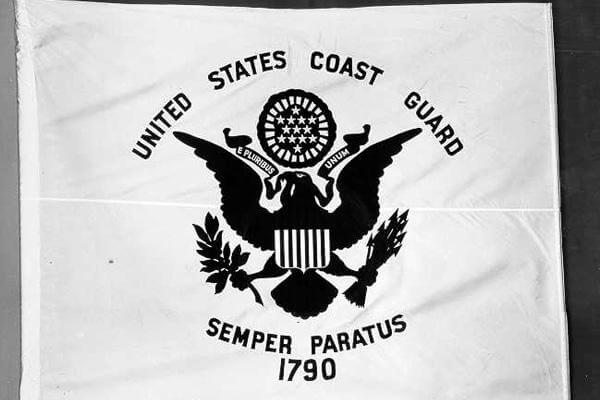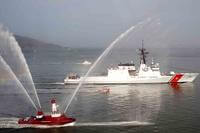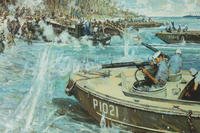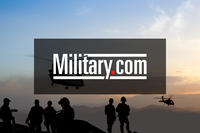The Coast Guard Standard
The origins of the Coast Guard standard are very obscure. It may have evolved from an early jack. At least one contemporary painting supports this theory. In an 1840 painting, the Revenue cutterAlexander Hamilton flies a flag very similar to today's Coast Guard standard as a jack. This flag, like the union jack, which is the upper corner of the United States flag, appears to be the canton or upper corner of the Revenue cutter ensign.
An illustration in 1917 shows the Coast Guard standard as a white flag with a blue eagle and 13 stars in a semi-circle surrounding it. At a later date, the words, "United States Coast Guard-- SemperParatus" were added.
After 1950, the semi-circle of stars was changed to the circle containing 13 stars. The Coast Guard standard is used during parades and ceremonies and is adorned by our 34 battle streamers. We are unique to the other services for we have two official flags, the Coast Guard standard and the Coast Guard ensign.
The Coast Guard Ensign
The initial job of the first revenue cutters was to guarantee that the maritime public was not evading taxes. Import taxes were the lifeblood of the new nation. Smuggling had become a patriotic duty during the revolution. If the new nation under the Constitution were to survive, this activity needed to be stopped.
Working within a limited budget, cutters needed some symbol of authority. Neither officers nor men had uniforms. How could a revenue cutter come alongside a merchant ship during an age of pirates and privateers and order it to heave to?
The solution was to create an ensign unique to the revenue cutter to fly in place of the national flag while in American waters. Nine years after the establishment of the Revenue Cutter Service, Congress, in the Act of March 2, 1799 provided that cutters and boats employed in the service of the revenue should be distinguished from other vessels by a unique ensign and pennant.
On August 1, 1799, Secretary of the Treasury, Oliver Wolcott, issued an order announcing that in pursuance of authority from the President, the distinguishing ensign and pennant would consist of, "16 perpendicular stripes, alternate red and white, the union of the ensign to be the arms of the United States in a dark blue on a white field."
The ensign was poignant with historical detail, inasmuch as in the canton of the flag, there are 13 stars, 13 leaves to the olive branch, 13 arrows and 13 bars to the shield. All corresponded to the number of states constituting the union at the time the nation was established. The 16 vertical stripes in the body are symbolic of the number of States composing the Union when this ensign was officially adopted.
This ensign soon became very familiar in American waters and served as the sign of authority for the Revenue Cutter Service until the early 20th century. The ensign was intended to be flown only on revenue cutters and boats connected with the Customs Service. Over the years it was found flying atop custom houses as well. President William Howard Taft, however, issued an Executive Order June 7, 1910, adding an emblem to the ensign flown by the Revenue cutters to distinguish it from the ensign flown from the custom houses, which read: "By virtue of the authority vested in me under the provisions of Sec. 2764 of the revised Statutes, I hereby prescribe that the distinguishing flag now used by vessels of the Revenue Cutter Service be marked by the distinctive emblem of that service, in blue and white, placed on a line with the lower edge of the union, and over the center of the seventh vertical red stripe from the mast of said flag, the emblem to cover a horizontal space of three stripes. This change to be made as soon as practicable."
At about this time, cutters began flying the U.S. flag as their naval ensign and the revenue ensign became the Service's distinctive flag.
When the service adopted the name Coast Guard, the Revenue Cutter Service's ensign became the distinctive flag on all Coast Guard cutters as it had been for the revenue cutters.
The colors used in the Coast Guard ensign today, as in the Revenue Cutter Service, are all symbolic. The color red stands for our youth and sacrifice of blood for liberty's sake. The color blue not only stands for justice, but also for our covenant against oppression. The white symbolizes our desire for light and purity.
As it was intended in 1799, the ensign is displayed as a mark of authority for boardings, examinations and seizures of vessels for the purpose of enforcing the laws of the United States . The ensign is never carried as a parade or ceremony standard.
The Jack and Commission Pennant
During its early years, the Revenue Cutter Service flew the canton (the upper corner of the flag nearest the staff) of the Revenue Cutter ensign as its jack. This practice persisted at least into the 1830s. Prior to the U.S. Civil War, the Revenue Cutter Service adopted as its new jack the canton of the United States Flag (the Union Jack) and this continues to this day.
Now, the jack is flown from the jackstaff only while at anchor. During the early years of the Service it was frequently flown on special occasions either at the jackstaff or atop the main mast while underway as well as when at anchor.
The Coast Guard commission pennant was created at the same time as the ensign in 1799. The original commission pennant bore the same style American eagle as the ensign, 16 vertical red and white stripes, and a white-over-red vertical tail.
Prior to the U.S. Civil War, the Revenue Cutter Service adopted a commission pennant which had thirteen blue stars on a white field, thirteen vertical red and white stripes, and a red swallowed tail.
Sometime after the Civil War, the Service adopted the same commission pennant as the U.S. Navy. This pennant has thirteen white stars on a blue field, thirteen vertical red and white stripes, and a red swallowed tail. The pennant is flown from the top of the main mast.
By 1930, however, the Service had again changed its commission pennant. This pennant, with an inboard section that is a blue field with white stars, thirteen vertical red and white stripes, and a red swallowed tail, is the same one currently in use. The interesting thing about this change in practice is that there was apparently no regulation that ordered the Service to change from that commission pennant which was also used by the U.S. Navy.





